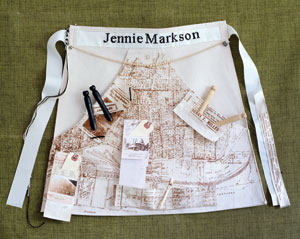October 2015 | view this story as a .pdf
Connected narratives that comprise this provocative installation by Jo Israelson open a window to Portland’s golden door. So many seekers of a new home on this side of the Atlantic landed on House, once known as the Ellis Island of the North.
By Jo Israelson
 In The Artist Way, Julia Cameron writes about Synchronicity and Spirituality:
In The Artist Way, Julia Cameron writes about Synchronicity and Spirituality:
Once you accept that it is natural to create, you can begin to accept a second idea: that the Creator will hand you whatever you need for the project. Be alert: there is a second voice, a higher harmonic, adding to and augmenting your inner creative voice. This voice frequently shows itself in synchronicity.
And, there is a Chinese saying: No Coincidence, No Story.
I am a storyteller. I tell stories through my art.
The Past is Prologue
I did not learn the history of Munjoy Hill (“The Hill”), Maine immigration, or the Casco Bay islands until I came home to care for my mom, Caroline Borofsky Israelson.
Over the course of a week of packing and moving her to an assisted-living facility, I encountered little-known facts about my neighborhood, my hometown, my heritage.
Sitting in the middle of the room were the boxes of unsorted and unlabeled photographs. My mom picked one up:
“This is a photo of the synagogue your great-grandfather started.”
Etz Chaim? My great-grandfather, Philip Levinsky. Why don’t I know I this?
A week later, while kayaking in Casco Bay, my guide remarks:
“House Island was known as the ‘Ellis Island of the North.’ In November of 1923, 218 immigrants were diverted to Casco Bay, Maine.”
House Island–immigrants detained and quarantined. Why don’t I know about this?
I stumble across this paragraph researching House Island.
“When immigrant ships landed in Portland in 1923 and 1924, and the passengers were maintained on House Island, the Portland Council of Jewish Women set up kosher kitchens there… They also assisted immigrants in entering this country…”
Kosher kitchens? Immigrant assistance? Why don’t I know about this?!
Coincidence, Part 2
The Etz Chaim Synagogue at the bottom of The Hill has recently been restored. Changing demographics, changing politics, changing economics led to the shuttering of its doors. It reopened as an “inclusive” synagogue and the Maine Jewish Museum.
I make an appointment to meet with the curator, Nancy Davidson. I tell her I am an artist. I tell her about my great grandfather. I tell her about House Island. I broach the idea of creating a piece for the museum. (When my mom was in high school, she spent summers as an au pair. One of her charges was the Maine Jewish Museum curator: Now, why didn’t I know about that?)
I am not sure if the “Coincidence Coordinator” is at work here. But there is a Yiddish word to describe what I am experiencing: Beshart–loosely translated as “meant to be.”
Welcoming the Stranger
In the Bible, the Quran, and Torah, there are mandates to welcome those who come in need–of food, of shelter, of protection.
My previous artwork has examined family relations, untold secrets, little-known histories. I make connections between seemingly disparate pieces of information.
The stories in my show Welcoming the Stranger: Building Understanding Through Community Based Art, presented at the Jewish Museum through October 26, are told in a site-specific art installation.
Abraham’s Tent greets visitors at the entrance to the Museum. It is an installation of textiles, sound recordings, and floor coverings. Weave the Tent events occurred throughout Portland to create the concurrent community exhibit and accompanying public events.
Sarah’s Generosity presents the history of the Jewish women who created a kosher kitchen on House Island. Each woman’s story is told in images transferred onto aprons.
Habeas Corpus presents the modern-day stories of immigrant cab drivers in Portland. Their voices will tell the story of all immigrants–current and past–and told from a taxi cab.
0n my way to my studio, I walk along the same streets where the Irish, Italian, Greek, and Jewish immigrants lived when they first arrived in Portland. They were asylum seekers and refugees–escaping a life of persecution and poverty to provide their families a better life.
Today, new Mainers live on those same streets. They too are asylum seekers and refugees–who follow in the footsteps of those early immigrants.
I am a storyteller. I tell stories through my art.
I create artworks about small moments in history that reflect larger issues within a contemporary context. The role of the House Island quarantine station and those who welcomed the stranger may serve us as we find our own ways to welcome the stranger today.
Visit the “Welcoming The Stranger” exhibit at the Maine Jewish Museum at 267 Congress Street in Portland (773-2339, mainejewishmuseum.org) through October 26. Portland native Jo Israelson is a multi-media installation artist and stone sculptor with a degree from the University of Maryland.





0 Comments